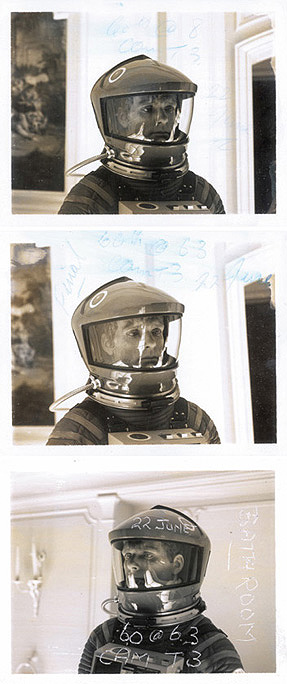[Original works from the Stanley Kubrick Estate.
Stanley Kubrick and Geoffrey Unsworth developed a system for calculating from the grey tones of b/w Polaroids the right lighting for filming
2001: A SPACE ODYSSEY.]
Kubrick seen
¬ Kubrick's films
¬ Filmography
¬ Biography
¬ Film programme
¬ Stanley Kubrick's (1928-1999) work has influenced with the film as an art form of the 20th century.
His career commenced in New York in the 1940s. Jazz, chess and photography were his main
interests. As a 17-year old Kubrick became a staff photographer for
Look magazine.
He taught himself the art of filming.
Kubrick later rejected FEAR AND DESIRE, his first feature film and witheld further
screenings. With KILLER'S KISS and THE KILLING he remodeled
the
film noir and demonstrated his talent to narrative and filmic composition. The
anti-war film, PATHS OF GLORY, starring Kirk Douglas, is regarded as an early masterpiece. SPARTACUS, the wide screen epic on the slave revolt in ancient
Rome, earned him worldwide acclaim and gave him the independence he had always sought.
Since LOLITA, based on the then scandalous novel by Vladimir Nabokov, all of Stanley
Kubrick's films were produced in England. With the war satire, DR. STRANGELOVE OR: HOW I
LEARNED TO STOP WORRYING AND LOVE THE BOMB, Kubrick finally established himself as the
most idiosyncratic major director of modern cinema. In 1968 he finished the
most ambitious project of his career - 2001: A SPACE ODYSSEY. For the lavish Special
Visual Effects the film was awarded an Oscar in the same year.
Stanley Kubrick's uncompromising way of working and his passion for detail also
characterise each of the following films: A CLOCKWORK ORANGE, THE SHINING and FULL
METAL JACKET. The film director died on 7 March, 1999 shortly after completing EYES WIDE SHUT.
"He created more than movies. He gave us complete environmental experiences that got
more, not less, intense the more you watched them."
Steven Spielberg
from: Christiane Kubrick. Stanley Kubrick - A Life in Pictures. London, 2002
¬ print

